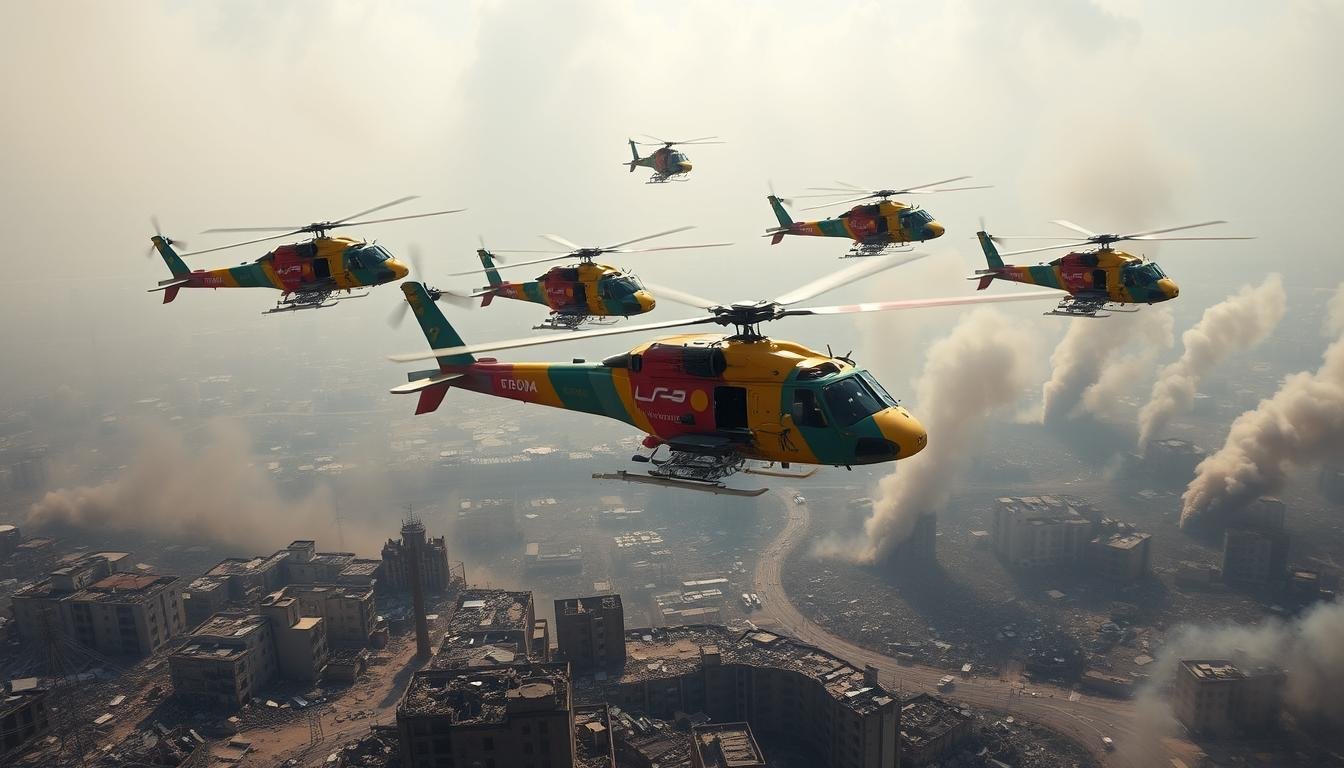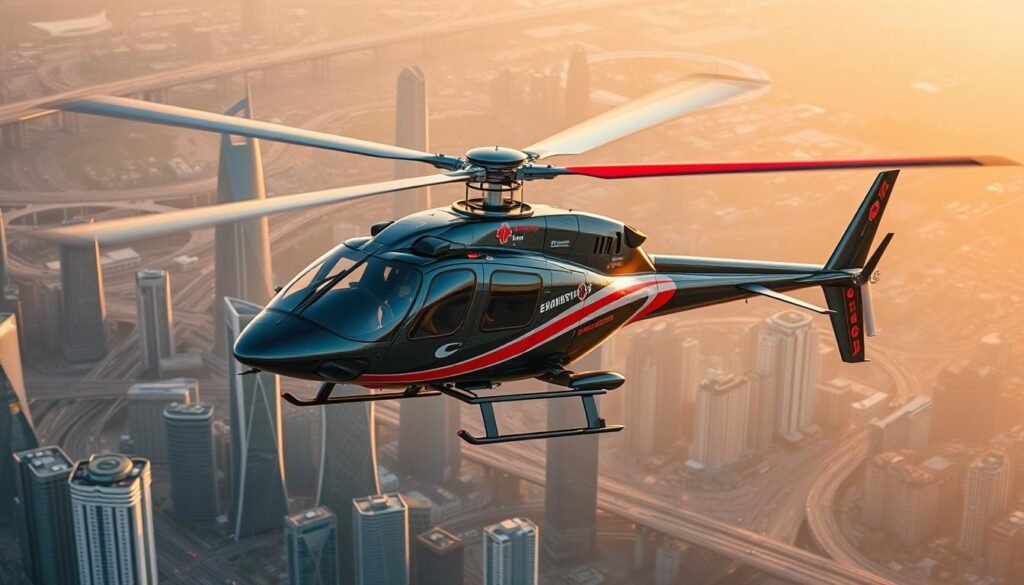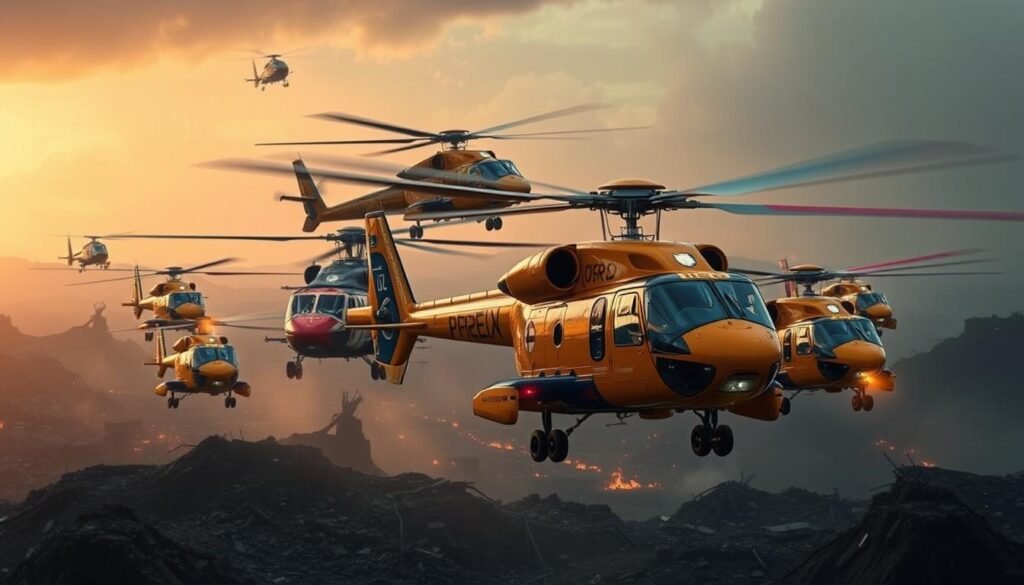One study found airborne teams cut time-to-care by more than half during major floods. That speed transforms outcomes for people trapped in remote areas or by collapsed roads.
Aircraft tailored for mountain, maritime, or urban missions bring unique capabilities. Mountain models pack powerful engines plus advanced avionics for high altitudes. Maritime variants offer flotation, corrosion-resistant materials, plus mission-specific equipment.
Modern systems such as thermal imaging and night-vision improve accuracy while reducing risk to crew. Telemedicine, modular cabins, hoists, stretchers, and obstacle-detection systems turn rotorcraft into flying emergency rooms.
In the United States, coordination with emergency services boosts effectiveness. When roads fail, air support links teams to care, extending operations into the toughest conditions with safety and speed.
Key Takeaways
- Airborne units sharply reduce time-to-care in disaster zones.
- Aircraft types vary by terrain to protect people and crew.
- Advanced systems improve search accuracy, lowering mission risk.
- Modular equipment allows medical stabilization en route.
- Coordination with ground teams multiplies lifesaving outcomes.
Search and Rescue Helicopters In Modern Disaster Response
When ground corridors collapse, air units serve as the primary lifeline to stranded communities.
Modern aircraft pair powerful engines with resilient avionics, night vision, and thermal imaging to find victims through smoke, dust, or low light. Modular cabins let crews switch from insertion to evacuation in minutes.
Telemedicine and remote monitoring allow clinicians to guide in-flight care in real time. Unmanned aerial vehicles add reconnaissance that improves situational awareness and crew safety.
Agencies prioritize systems and equipment that balance endurance, lift, and redundancy. That mix supports sustained rescue operations in austere zones while preserving safety margins for pilots and teams.
- Air mobility bypasses collapsed roads and flooded corridors during large-scale incidents.
- Advanced navigation and obstacle detection limit exposure in degraded weather conditions.
- Interoperability and data links unify communication across agencies for faster mission tempo.
| System | Primary Purpose | Operational Benefit |
|---|---|---|
| Thermal Imaging | Detect heat signatures | Improves locate rate in low light |
| Modular Cabin | Configurable patient care | Speeds multi‑phase evacuations |
| Telemedicine Links | Real‑time clinical consults | Raises in‑flight treatment quality |
For case studies and operational context, see a report on how helicopters save lives and an analysis of how air support revolutionized operations.
Search and Rescue Helicopters: Leading Models, Features, And Capabilities
Leading airframes combine payload, avionics, and cabin layouts to meet diverse mission demands.

Bell 407HP: Speed, Maneuverability, And All-Weather Precision
The Bell 407HP pairs 161 mph top speed with a 2,500 lb external capacity and a six‑passenger cabin. Its quick handling favors short‑turn insertions where precision matters.
Bell 206‑B3: Proven Reliability And Safety Record
The 206‑B3 is valued for low operating cost and a 300‑mile range. Small crews rely on its proven safety for frequent training and routine operations.
Bell 429: Advanced Avionics And Spacious Cabin For Rescue Operations
The Bell 429 offers a roomy seven‑seat cabin, 2,000 lb lift, and 390‑mile range. Avionics support makes medical layouts simple and effective.
Airbus AS350 B3: High‑Altitude Performance In Extreme Conditions
Designed for thin‑air work, the AS350 B3 reaches ridgelines others cannot. It combines 160 mph speed with heavy external lift for mountain tasks.
Sikorsky S‑76: Long Range And Heavy External Load Capacity
S-76 carries up to 12 passengers, 5,000 lb external loads, and extended range to support long missions without sacrificing cabin access.
Eurocopter EC135: Urban SAR Agility And Air Ambulance Roles
The EC135 excels in tight urban corridors with compact dimensions, a flexible cabin, and near‑160 mph cruise for rapid medevac hops.
AgustaWestland AW139: Built For Versatility And Challenging Environments
AW139 blends a 193 mph top speed with a 675‑mile range and 15‑seat capacity. Agencies use it where built versatility and endurance matter.
Sikorsky UH‑60 Black Hawk: Robust Design For Extreme Conditions
The UH‑60 Black Hawk delivers 9,000 lb external lift and proven reliability in harsh conditions. It is a go‑to platform for heavy extraction tasks.
AW189 SAR: Long‑Range Missions With Dual Hoist And Advanced Sensors
AW189 adds dual hoists, FLIR/TV, and multiple comms to raise safety margins over water. Cabin capacity exceeds a dozen personnel for large evacuations.
S‑92 SAR: Maritime Capability, Auto‑Hover, And Auxiliary Fuel Options
The S‑92 SAR offers auto‑hover, emergency flotation, and optional auxiliary tanks for extended over‑water work. Learn more about the S‑92’s maritime features on the S‑92 product page.
Common Missions And Use Cases Across Air And Ground Rescue Teams
Aerial units support diverse operations, delivering critical care, water drops, and long-range supply runs. They adapt equipment and crew roles to meet mission needs across coastal, mountain, urban, and offshore areas.

Air Ambulance And Medevac: In-Flight Care And Rapid Transport
Air ambulances provide on-board stabilization with ventilators, monitors, and IV systems. Teams coordinate handover with ground clinicians to keep care continuous during transfer.
Firefighting Support: Bambi Buckets, Thermal Imaging, And Mapping
Pilots use cargo hooks and Bambi buckets for water or retardant drops. Infrared cameras map hot zones and guide crews through smoke and poor visibility.
Maritime Operations: Hoists, Rescue Baskets, And Corrosion Resistance
Over-water missions use hoists, baskets, life rafts, and corrosion‑resistant fittings. Advanced avionics and de-icing gear help crews operate in worsening weather conditions.
Mountain Rescue: High-Altitude Hoist Work And Rugged Terrain Access
High-altitude missions demand powerful engines, specialized rotors, and robust winches. When landing is impossible, hoist work puts teams where ground access fails.
Urban Search And Rescue: Confined-Area Hover And Stabilization Systems
In cities, compact platforms use stabilization systems and sensors to hover in tight spaces. Crews pair with responders on the ground for precise extractions.
Disaster Relief And Remote Area Rescue: Sling Loads And Auxiliary Fuel
Large cargo bays and sling systems move supplies into isolated areas. Auxiliary tanks and long-range navigation extend mission endurance across vast zones.
Offshore Oil And Gas: Long-Range Flights And Adverse Weather Navigation
Offshore work combines long legs with inspection gear and external hooks. Teams train for harsh sea weather to protect personnel and platform operations.
Police Pursuits And Law Enforcement: Night Vision, IR, And Comms
Law enforcement platforms carry high-power cameras, infrared sensors, and secure comms. Those tools let pilots coordinate aerial oversight while protecting people on the ground.
Quick Comparison Of Typical Mission Equipment
| Mission | Key Equipment | Typical Conditions | Primary Benefit |
|---|---|---|---|
| Air Ambulance | Ventilators, Monitors, Med Kits | Urban, Rural | Rapid Stabilization & Handover |
| Firefighting | Bambi Bucket, IR Camera, Hooks | Smoke, Low Visibility | Targeted Drops & Hotspot Mapping |
| Maritime | Hoist, Rescue Basket, De‑icing | Open Water, Rough Weather | Safe Recovery Over Water |
| Remote/Mountain | Sling Load, Auxiliary Fuel, Winch | High Altitude, Isolated Areas | Extended Range & Access |
For an operational overview, readers can consult a search and rescue overview and review recent technology advancements that improve mission outcomes.
Crew, Training, And Coordination That Elevate Rescue Missions
Well-trained crews turn complex missions into routine procedures through disciplined drills and clear roles. Training emphasizes hover control, rapid decision-making, and tight coordination across aircrews, controllers, and ground rescue teams. Simulators and live exercises sharpen skills for confined-area operations and adverse weather.

Hover Precision And Confined-Area Operations
Hover precision is central to safe winch and hoist work near cliffs, trees, or structures. Pilots practice simulator profiles and live lifts until timing and control become automatic.
Decision-Making Under Pressure And Crew Safety
Pilots use checklists plus trained judgment to adapt when conditions shift. Clear role assignment helps the crew protect patients, bystanders, and flight safety without delay.
Real-Time Communication With Ground Rescue Teams
Reliable communication aligns landing zones, triage priorities, and staging of systems and equipment. Real-time communication ensures medics and pilots act as one team during patient transfer.
Operating In Extreme Weather Conditions
Scenario-based drills expose crews to gusts, low visibility, and system failures. Recurrent cycles validate procedures so operations continue safely in extreme conditions.
| Focus Area | Training Method | Operational Benefit |
|---|---|---|
| Hover Control | Simulators, Live Hoist Drills | Precise placement in confined sites |
| Decision-Making | Stress Scenarios, Checklists | Safer, Faster Choices |
| Coordination | Cross-Agency Drills | Unified Tempo Between Air And Ground |
| Weather Ops | Real-Time Simulations | Resilience In Severe Conditions |
For an operational look at common pilot challenges and training, see challenges faced by helicopter pilots.
Technology, Systems, And Parts Support That Improve Mission Outcomes
When every minute counts, systems that enhance visibility and extend range change outcomes for crews and survivors.

Avionics, Night Vision, And Thermal Imaging For Search Precision
Advanced avionics plus night vision and thermal imaging reveal heat signatures and terrain detail. Crews use these systems to trim exposure time and pinpoint targets in low light.
Cabin Modularity, Safety Systems, And Range Capabilities
Modular cabins let teams switch roles fast—from insertion to medevac. Obstacle detection and collision-avoidance systems protect pilots and patients during dynamic operations.
Multi-Band Communication And Real-Time Telemedicine
Multi-band communication links and telemedicine gear connect air medical teams with physicians. Real-time monitoring improves clinical decisions and in-flight care quality.
Auxiliary Fuel, Endurance, And Over-Water Safety Features
Optional auxiliary fuel tanks extend range for long sorties into remote zones. Over-water features like emergency flotation and life rafts raise survival odds if a ditching occurs.
UH-60 Black Hawk Components And Logistics Support
Cutting Dynamics supplies certified Black Hawk parts across cockpit, cabin, tail, and rotor zones. AS9100 and ISO 9001 certifications and clear part numbers streamline maintenance and readiness.
| System | Key Benefit | Example |
|---|---|---|
| Thermal/Night Vision | Faster target ID | FLIR/IR suites on AW189 |
| Modular Cabin | Rapid role changes | Medevac to insertion layouts |
| Auxiliary Fuel | Extended range | S-92 optional tanks |
| Certified Parts | Predictable logistics | Black Hawk part numbers (PX-70950, 70249-92024-013) |
For more on platform types and capability trade-offs see different types of helicopters.
How Air Support Integrates With Ground Rescue For Faster Response
Coordinated air and ground teams rely on clear protocols to shrink response time in complex incidents.

Incident command frameworks align aircrews, controllers, and ground rescue teams. They use real-time communication to set landing zones, secure cordons, and move patients without delay.
Dispatch triage matches helicopters to missions by distance, payload, and weather. That process helps teams respond emergencies while keeping crew and people safe.
Common radio plans and shared data let operations track search progress. Teams update taskings and pivot search rescue missions as conditions change.
| Coordination Area | Primary Action | Operational Benefit |
|---|---|---|
| Staging & Handoff | Predefined handoff points | Reduces transfer delays |
| Dispatch Triage | Asset matching | Efficient mission assignment |
| Redundancy | Dual comms & Nav | Maintains operations during outages |
Integrated training builds familiarity between air and ground rescue teams so pilots can vector precisely in urban grids or rugged terrain.
For details on comms gear that supports these links, see communication systems in emergency response.
Conclusion
Fast, versatile rotorcraft often form the first line of response in complex emergencies.
They unite speed, range, and safety to move people from danger to care. Proven platforms with built versatility serve coastal, mountain, urban, and offshore areas under difficult weather conditions.
Investments in systems such as night vision, thermal imaging, obstacle detection, and telemedicine raise mission precision and survivability. For water operations, flotation, life rafts, and robust cabins add vital capacity while preserving range and speed.
Standardized training keeps pilots and crews precise under pressure, shortening timelines from search to extraction. As agencies modernize fleets, cabin flexibility and logistics support will define how each rescue helicopter adapts to new threats.
For operational context on helicopter roles in search rescue operations, consult this practical guide — Helicopters in SAR: Operational Guidance.
FAQ
What roles do helicopters play in modern disaster response?
Aircraft provide rapid access to isolated areas, deliver medical evacuation, transport supplies, perform aerial reconnaissance with thermal imaging, and assist ground teams with hoisting and sling-load operations. They extend reach where roads are blocked and offer critical situational awareness for incident commanders.
Which helicopter models are commonly used for air medical evacuation?
Common medevac platforms include the Bell 429 and Eurocopter EC135 for urban and regional work, the Sikorsky S-76 for longer-range transfers, and the AW139 where cabin space and modular medical fit-outs are needed. These types balance cabin size, range, and rapid loading capability.
How do helicopters operate safely in maritime rescues?
Maritime missions rely on corrosion-resistant components, winches and rescue baskets, auto-hover features, and crews trained in over-water procedures. Auxiliary fuel options and flotation systems extend endurance and survivability during offshore operations.
What equipment improves search precision during night or low-visibility missions?
High-grade avionics, night-vision goggles, forward-looking infrared (FLIR) sensors, and multi-band radios enable precise navigation, target acquisition, and coordination with surface teams. Real-time video links support commanders and medics on the ground.
How do crews prepare for confined-area and mountain hoist operations?
Crews undergo specialized training in confined-area hover, mountain aerology, and hoist procedures. Pilots practice power management for high-altitude conditions while winch operators and rescue specialists rehearse patient rigging and rapid transfer techniques.
What capabilities matter most for long-range or offshore missions?
Endurance, auxiliary fuel tanks, payload capacity, reliable engines, and advanced navigation suites are crucial. Platforms such as the Sikorsky S-92 and AW189 offer extended range, heavy external-load capacity, and systems designed for adverse weather and over-water transit.
How is coordination handled between air and ground teams during a complex incident?
Multi-band communications, standardized radio procedures, and unified incident command protocols enable seamless handoffs. Air crews share live telemetry and imagery while ground teams advise on access points, patient condition, and landing zone safety.
What maintenance and logistics support improve mission readiness?
Robust parts supply chains, scheduled avionics checks, engine health monitoring, and field-repair kits reduce downtime. Support for specific platforms — including UH-60 Black Hawk components for military-style operations — ensures availability when demand surges.
How do teams manage operations in extreme weather?
Decision-making combines meteorological forecasting, aircraft performance limits, and crew risk assessment. Pilots use de-icing systems, terrain-following procedures, and alternate routing while commanders may switch to unmanned assets or delay missions if conditions exceed safety margins.
What measures enhance safety during high-tempo disaster relief missions?
Safety comes from redundant systems, crew rest policies, clear communication, and real-time health monitoring of aircraft. Standard operating procedures for contested airspace, night operations, and patient handling reduce accidents and improve outcomes.
As technology evolves, one truth stays constant: When the worst happens, helicopters are the first hope for survival.



